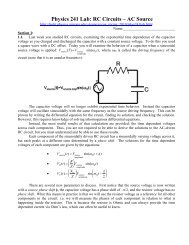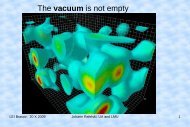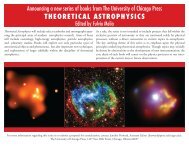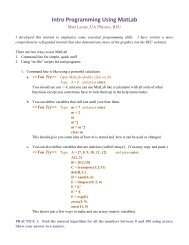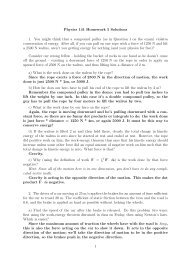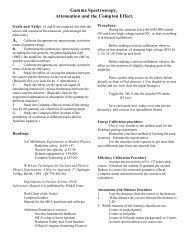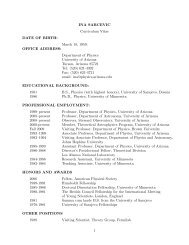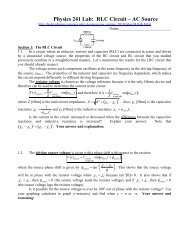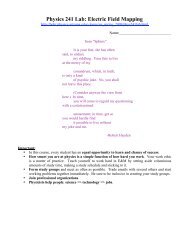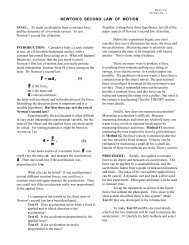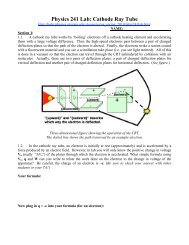Test 1 - Practice
Test 1 - Practice
Test 1 - Practice
Create successful ePaper yourself
Turn your PDF publications into a flip-book with our unique Google optimized e-Paper software.
Physics 121 – Mechanics<br />
<strong>Test</strong> 1 <strong>Practice</strong><br />
name:__________________<br />
<strong>Test</strong> 1 will include material from chapters 1-7. You should review your homework<br />
problems, quizzes, recitation problems, etc. An incomplete and brief summary of the<br />
topics and concepts this includes is given by:<br />
<strong>Test</strong> 1 Summary of Material Covered:<br />
Kinematics (motion)<br />
1) kinematics in one dimension<br />
a. one object with constant acceleration<br />
b. x(t) vs. t, v(t) vs. t, a(t) vs. t graph problems<br />
c. two objects with constant velocity<br />
d. use calculus to derive motion equations, derivatives and integrals<br />
2) kinematics in two dimensions<br />
a. one object projectile motion (constant acceleration in one dimension and zero<br />
acceleration in the other dimension)<br />
b. one object centripetal acceleration<br />
Forces (cause of motion)<br />
3) one object linear motion with and without friction<br />
a. using Newton’s 1 st & 3 rd laws and the principle of superposition to add find many<br />
forces and add to get F net .<br />
b. using Newton’s 2 nd law to relate F net to a net : force information to kinematics<br />
information (motion)<br />
c. some common systems<br />
1) inclined plane<br />
2) elevator<br />
3) unstretching, massless rope<br />
4) mass suspended by pulley<br />
5) mass on spring
4) one object circular motion<br />
a. constructing a free body diagram to find the sum of the component forces that<br />
give F net = F net,cent . Remember, the centripetal force is not a real force but a<br />
description of how all the real, physical forces combine to cause circular motion.<br />
b. F net,cent<br />
= mv 2<br />
r<br />
c. note: be able to convert revolutions per minute to speed<br />
5) two objects connected<br />
!<br />
a. share common a net magnitude: ex.<br />
F net,A<br />
m A<br />
= F net,B<br />
m B<br />
b. common situations<br />
1) two masses connected by rope and pulley<br />
2) two masses on surface touching<br />
!<br />
6) two objects forces on one another<br />
a. gravity between two objects, find F G<br />
1) find g surface for any planet given M and R<br />
2) relate F G to circular orbit centripetal acceleration on smaller mass orbiting<br />
larger mass<br />
Work (connecting forces to energy)<br />
7) calculating work depending on the complexity of the situation<br />
a. one dimension, constant force: W = ±Fd<br />
b. two dimensions, constant force: W = F r<br />
• d<br />
r<br />
c. one dimension, position dependent force: W = F(x)dx<br />
!<br />
x i<br />
8) relating kinematics information ! to force information using W net<br />
= "K<br />
9) some special situations<br />
a. pulling wagons<br />
!<br />
b. inclined planes<br />
!<br />
c. springs<br />
x f<br />
"
<strong>Test</strong> 1 <strong>Practice</strong> Problems:<br />
Kinematics (motion)<br />
1) kinematics in one dimension<br />
a. one object with constant acceleration<br />
An object moving +30 m/s forward brakes with an acceleration of -5 m/s 2<br />
for 10 seconds. What is its velocity and where is it located in relation to<br />
the position where braking first occurred?<br />
b. x(t) vs. t, v(t) vs. t, a(t) vs. t graph problems<br />
An object initially at rest at the origin accelerates for 2 seconds at +4 m/s 2 ,<br />
and then accelerates at -12 m/s 2 for 1.5 seconds. Construct an x(t) vs. t<br />
graph and determine the final position of the object.<br />
c. two objects with constant velocity<br />
Two objects are initially 50 m apart. Object A is moving to the right with a<br />
constant velocity of 22 m/s. Object B is moving with a constant speed of 17<br />
m/s. Find the position and time of collision if object B is moving to the left<br />
and the position and time of collision if object B is moving to the right.<br />
d. use calculus to derive motion equations, derivatives and integrals<br />
An object is initially located at x o =5 m. Given the velocity equation<br />
v(t)=4t 4 , find equations to describe the position and acceleration of the<br />
object.<br />
2) kinematics in two dimensions<br />
a. one object projectile motion (constant acceleration in one dimension and zero<br />
acceleration in the other dimension)<br />
A basketball is thrown from an initial height of 2 m with a velocity of<br />
15 m/s at angle of 78 o above the horizon. The ball rises into the air in a<br />
parabolic arc, reaches the top of its arc, then begins to fall downward. It<br />
strikes the rim of the basket 3.2 m high. How much time passes from the<br />
ball being thrown to when it struck the rim?<br />
b. one object centripetal acceleration<br />
A speck of dust lies on the edge of a compact disc 10 cm in diameter. If the<br />
disc spins at 200 revolutions per minute, what is the magnitude of the<br />
centripetal acceleration of the dust speck?
Forces (cause of motion)<br />
3) one object linear motion with and without friction<br />
a. using Newton’s 1 st & 3 rd laws and the principle of superposition to add find many<br />
forces and add to get F net .<br />
b. using Newton’s 2 nd law to relate F net to a net : force information to kinematics<br />
information (motion)<br />
c. some common systems<br />
1) inclined plane<br />
How long does it take a 5 kg object to slide 3 meters down a 45 o ramp<br />
starting from rest with a coefficient of friction of 0.1?<br />
2) elevator<br />
What will a weight scale read in an elevator moving at a constant 4 m/s<br />
upward? If this upward moving elevator takes 3 s to come to a stop during<br />
a period of constant acceleration, what will the scale read as it comes to a<br />
stop?<br />
3) unstretching, massless rope<br />
An emergency helicopter is accelerating upward at 3 m/s 2 . A cord attached<br />
to the helicopter carries a rescue worker and two injured hikers in a basket<br />
with a total mass of 360 kg. What is the tension in the cord?
4) mass suspended by pulleys<br />
In the following compound pulley system, a 7 kg mass is attached to the<br />
lower pulley by cord 2 while the upper compound pulley is attached to the<br />
ceiling by cord 3. A person holds the end of cord 1. Find the tension force<br />
in each of the three cords of the system if the mass is at rest.<br />
5) mass on spring<br />
A mass moves in a horizontal circle on a frictionless surface at a constant<br />
speed, v. It is attached to a spring with spring constant k s and equilibrium<br />
distance d that is displaced a distance of x while the mass moves. Write an<br />
expression that gives the speed in terms of d, x, k s , and the mass, m.
4) one object circular motion<br />
a. constructing a free body diagram to find the sum of the component forces that<br />
give F net = F net,cent . Remember, the centripetal force is not a real force but a<br />
description of how all the real, physical forces combine to cause circular motion.<br />
b. F net,cent<br />
= mv 2<br />
r<br />
!<br />
A 0.43 kg ball hangs from a pole by a rope (tether ball) at an angle of 25 o .<br />
The ball moves in a perfect circle with a speed of 7.6 m/s. Find the length<br />
of the rope.<br />
5) two objects connected<br />
F net,A<br />
a. share common a net magnitude: ex. = F net,B<br />
m A<br />
m B<br />
b. common situations<br />
1) two masses connected by rope and pulley<br />
!<br />
Two masses are connected by a rope that hangs over a fixed, frictionless<br />
pulley. One mass is 2.22 kg and the other is 3.33 kg. Find the acceleration<br />
of the blocks when allowed to move. Also find the upward force that must<br />
be exerted on the pulley to keep it stationary.
2) two masses on surface touching<br />
Two masses on a surface are touching and a force is applied to one of<br />
them. If m A =4.6 kg and m B =7.9 kg, and if the coefficient of friction of A is<br />
0.6 and of B is 0.4, find the minimum force that needs to be applied to<br />
accelerate the masses. If twice this force is provided, find the acceleration<br />
of the masses.<br />
6) two objects with forces on one another<br />
a. gravity between two objects, find F G<br />
1) find g surface for any planet given M and R<br />
A large, dense planet has a mass of 5.54x10 28 kg and a radius of 3.45x10 6<br />
meters. Find the gravitational acceleration at the surface.<br />
2) relate F G to circular orbit centripetal acceleration on smaller mass orbiting<br />
larger mass<br />
The planet in the previous problem has a moon of mass 2.54x10 22 kg. If it<br />
orbits with a speed of 12,345 m/s, what is the radius of its orbit?<br />
Work (connecting forces to energy)<br />
7) calculating work depending on the complexity of the situation<br />
a. one dimension, constant force: W = ±Fd<br />
A 62 kg person climbs a 6 m high vertical ladder at a constant 1.56 m/s<br />
velocity. Find the ! following amounts of work that were done on the person<br />
by each force: W gravity , W legs and W net .<br />
b. two dimensions, constant force:<br />
W = F r<br />
• d<br />
r<br />
A parent pulls a 38.3 kg child on a sled (of negligible mass) with a rope at<br />
a 73.0 o angle above ! the horizon. The coefficient of friction is 0.05, and the<br />
parent pulls the child 10 meters with 70.2 N of force. If the child starts<br />
from rest, find the net work done on the child. What are the components of<br />
work that generate this net work on the child?
c. one dimension, position dependent force: W =<br />
F(x)dx<br />
A 0.86 kg mass is attached to a spring with a spring constant of 6 N/m and<br />
an equilibrium distance of 0.04 ! m. Find the work done by the spring on the<br />
mass if the mass is moved from the equilibrium position to 0.12 m away<br />
from the equilibrium position.<br />
x f<br />
"<br />
x i<br />
8) relating kinematics information to force information using<br />
W net<br />
= "K<br />
A 297 kg object is falling straight down. 10 m above the ground, it has a<br />
speed of 15 m/s. Calculate the net work ! done on the falling object from its<br />
initial position of 10 m to where it hits the ground. Using this net work,<br />
find the speed of the object just before it struck the ground.<br />
9) some special situations<br />
a. pulling wagons<br />
(see above)<br />
b. inclined planes<br />
c. springs<br />
You pull a tired friend up a mountain at a constant speed by means of a<br />
rope attached to your waists. The mountain has a 30 o slope, and the rope<br />
is parallel to the ground. Your friend is able to lift their feet so that there is<br />
effectively no friction, but cannot aid at all in their own propulsion. If the<br />
friend (and gear) weighs 323 N, what is the amount of work you must<br />
provide to your friend to pull them each and every meter? What is the<br />
amount of work they do to you for a single meter? If you are able to<br />
maintain 0.5 m/s speed, what is the power you are doing to the friend?<br />
(see above)




